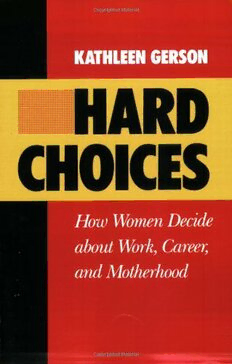
Hard Choices: How Women Decide About Work, Career and Motherhood PDF
Preview Hard Choices: How Women Decide About Work, Career and Motherhood
HARD CHOICES California Series on Social Choice and Political Economy Edited by Brian Barry and Samuel L. Popkin How Women Decide HARD about Work, Career, CHOICES and Motherhood KATHLEEN GERSON UNIVERSITY OF CALIFORNIA PRESS Berkeley I Los Angeles I London This book is a print-on-demand volume. It is manufactured using toner in place of ink. Type and images may be less sharp than the same material seen in traditionally printed University of California Press editions. The paper used in this publication meets the minimum requirements of ANSI/NISO Z39.48-1992(R 1997)(Permanence of Paper) University of California Press Berkeley and Los Angeles, California University of California Press, Ltd. London, England © 1985 by The Regents of the University of California Printed in the United States of America Library of Congress Cataloging in Publication Data Gerson, Kathleen. Hard choices. Bibliography: p. Includes index. 1. Women—United States—Social conditions. 2. Mothers—United States—Social conditions. 3. Women— Employment—United States—History. 4. Mothers—Employ- ment—United States—History. 5. Family size—United States—History. 6. Women—United States—Psychology. I. Title. HQ1420.G4 1985 305.4'0973 84-8602 ISBN 0-520-05745-7 CONTENTS List of Figures vii List of Tables ix Preface xiii Acknowledgments xvii I Women's Work and Family Decisions: The "Subtle Revolution" in Historical Perspective 1 Changing Work and Family Patterns 3 Cohorts and Social Change 9 Alternative Paths in Adult Development 11 2 Explaining Women's Behavior: A Theoretical Overview 23 The Structural Coercion Approach 24 The Voluntarist Approach 29 A Developmental Approach 37 3 Baselines 43 Childhood Socialization 44 Starting Points 59 Ambivalence and Change 65 V vi / Contents 4 Veering Away from Domesticity 69 Rising Work Aspirations and Family Ambivalence 70 Conclusion 89 5 Veering Toward Domesticity 92 Declining Work Aspirations and the Home as a Haven 93 Comparing Domestic and Nondomestic Groups 115 Stability and Change in Adulthood 117 Conclusion 121 6 Homemaking Versus Childlessness 123 The Persistence of Domestic Patterns 127 Nondomestic Responses 132 Choosing to Stay Childless 138 7 Combining Work and Motherhood 158 Reluctant Motherhood 159 Childlessness Versus Reluctant Motherhood 184 Domestic Versus Nondomestic Responses 186 8 The Changing Contours of Women's Place 191 Development, Choice, and Structured Alternatives 191 The Limits of Socialization, Personality, and Dominance Models 197 Work and Family Structures in Transition 204 Conclusion 212 9 The Politics of Parenthood 216 The Limits of Change and the Conflict Among Women 216 Gender Equality, Social Policy, and the Role of the State 224 Appendix A Tables 233 Appendix B Methodology 240 Appendix C Sample Characteristics 248 Appendix D Interview Schedule 257 Bibliography 287 Index 303 LIST OF FIGURES 1 Comparisons Between the U.S. Birthrate and the Female Labor Force Participation Rate, 1890-1980 6 2 Alternative Adult Pathways 22 3 Alternative Adult Pathways and Future Plans 125 4 Rates of First Marriage, Divorce, and Remarriage for U.S. Women: 1921-1977 206 5 Real Disposable Income for Workers with Three Dependents, 1947-1979 (in Constant Dollars) 208 vn This page intentionally left blank LIST OF TABLES 1 Mother's Attitude Toward Working When Her Children Were Young by Mother's Work Experience 46 2 Percent Domestic by Mother's Work Pattern 46 3 Percent Domestic by Mother's Fertility Behavior 47 4 Percent Domestic by Parental Expectations 55 5 Percent Currently Domestic by Baseline Orientation and Educational Level 67 6 Occupation by Education 81 7 Adult Pathway by Frequency of Triggering Events for Initially Domestic Respondents 118 8 Adult Pathway by Frequency of Triggering Events for Initially Nondomestic Respondents 119 Appendix A: Tables A.I Female Labor Force Participation Rates by Marital Status, Children in the Household, Age, and Percent of Full-Time Workers, 1950-1980 233 IX
